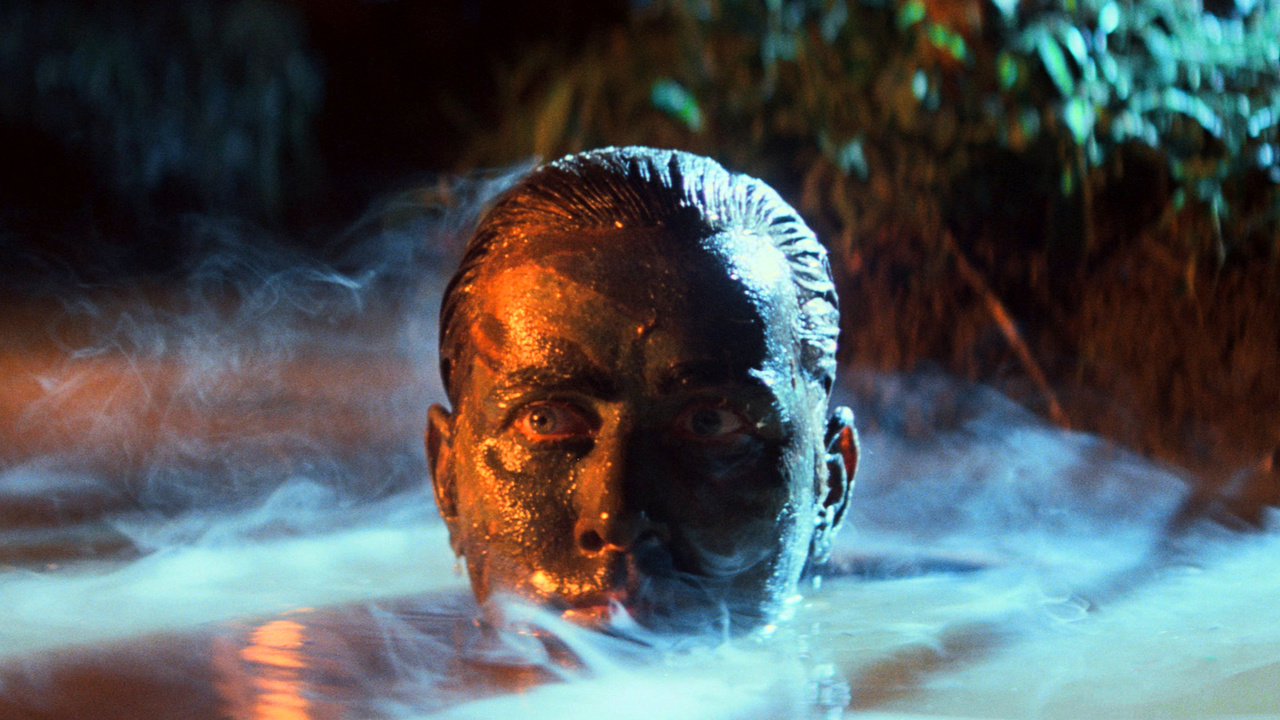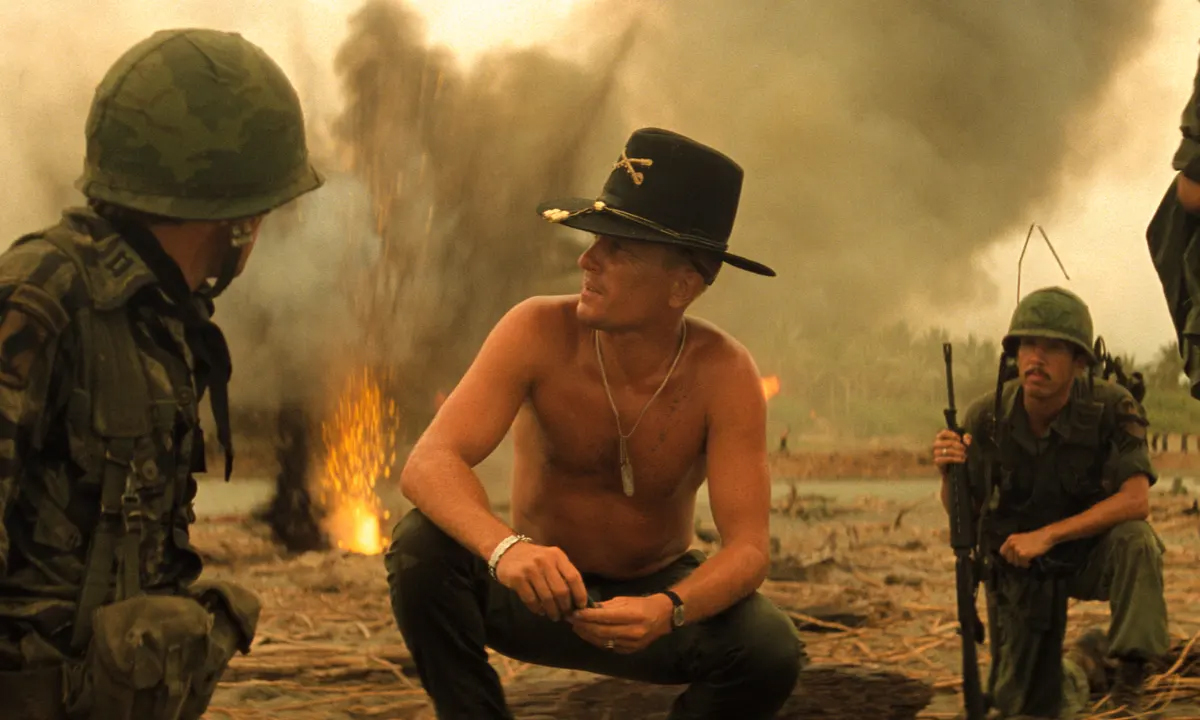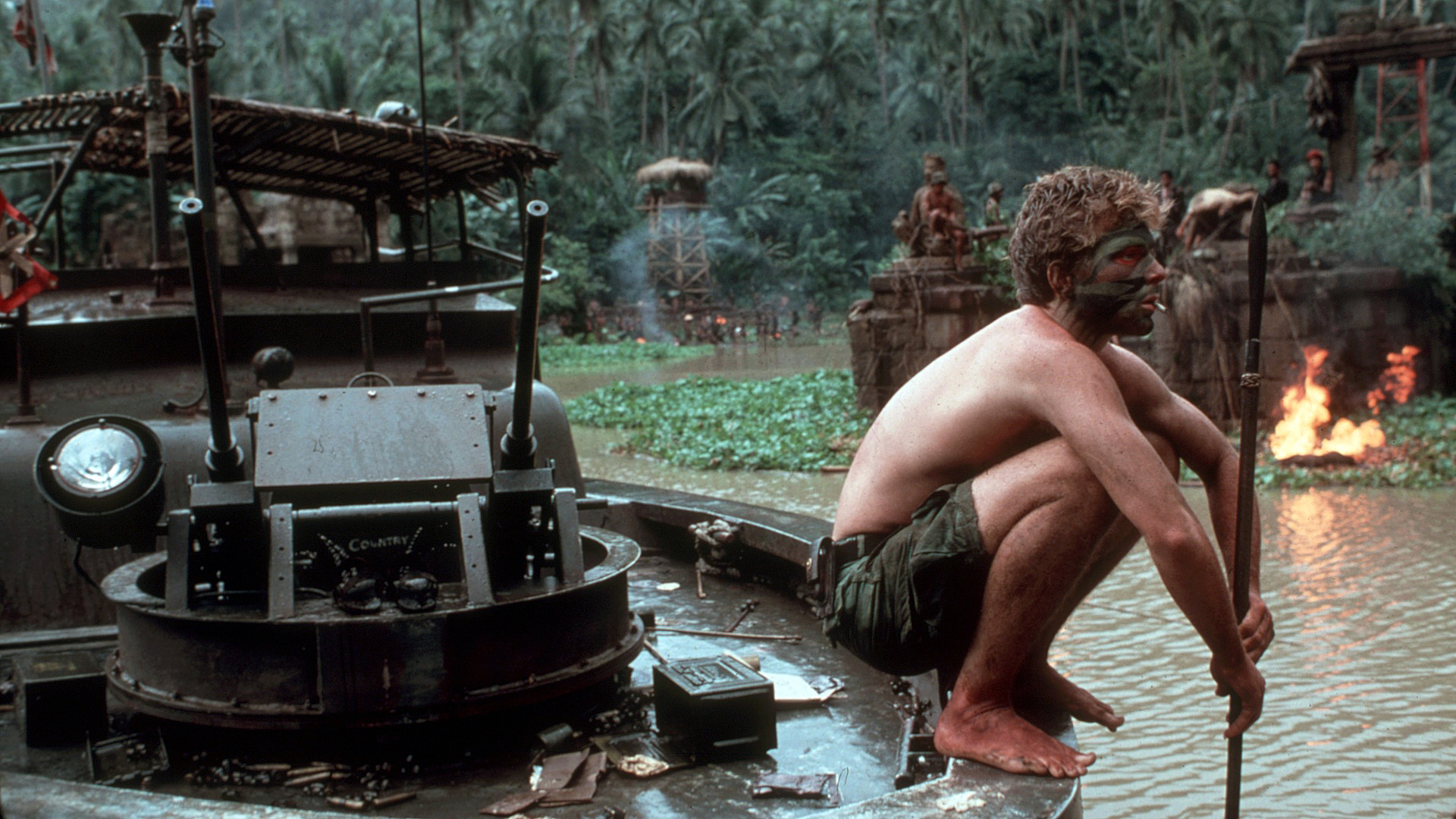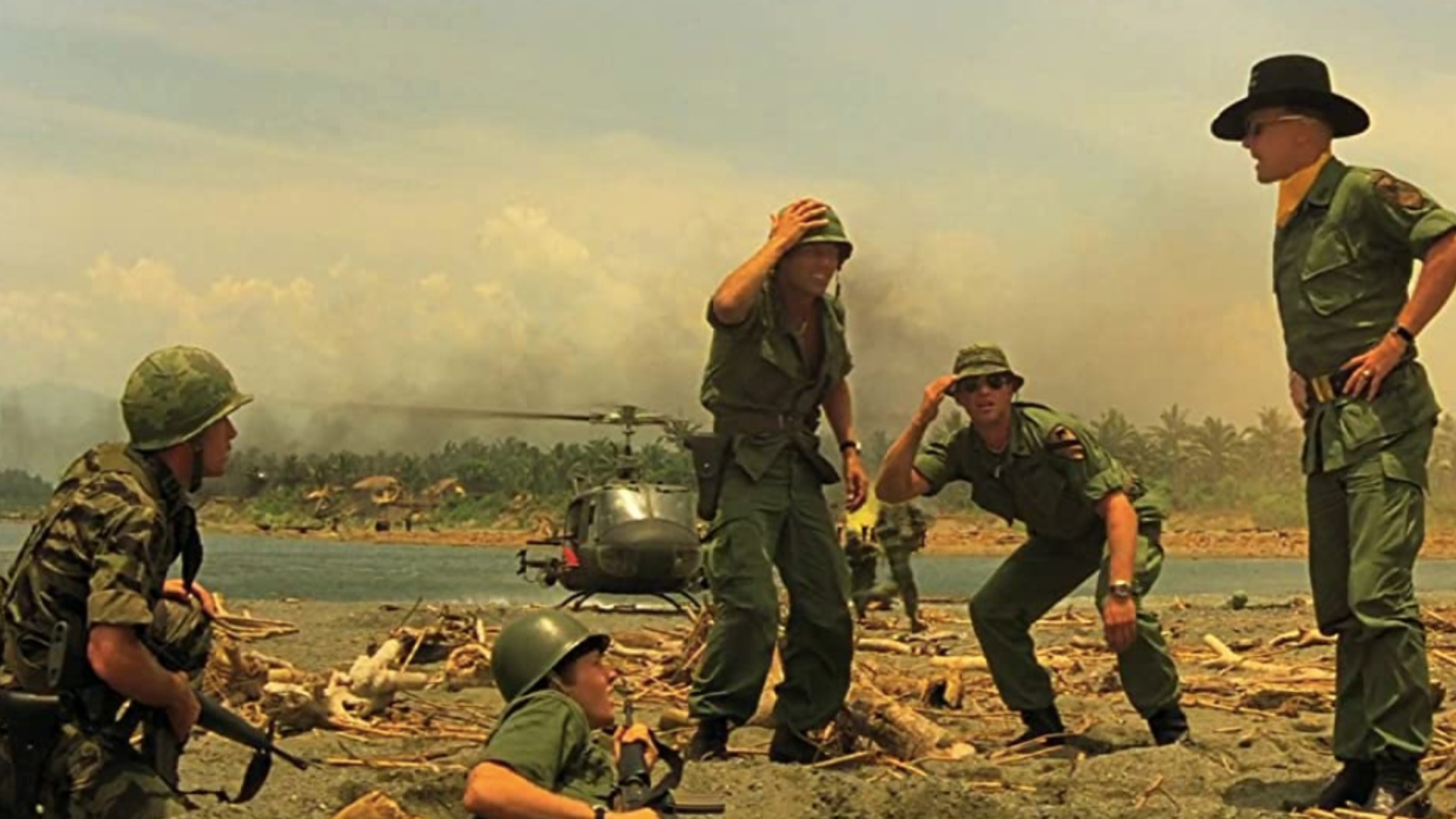Apocalypse Now is less a movie and more a phantasmagoric experience, a weird dreamlike collection of imagery and ideas that tries to fashion some sense out of the American War in Vietnam.
Allowing for the release of the John Wayne propaganda vehicle The Green Berets in 1968, Apocalypse Now arrived alongside Coming Home and The Deer Hunter as part of the first wave of Hollywood productions to truly grapple with the experience of that conflict. Director Francis Ford Coppola rejected strict literalism, with veteran Dale Dye opining that the film had “nothing to do with the average guy’s experience in Vietnam.”
However, this trance-like quality reflected some underlying truth. Doug Claybourne claimed the finished film captured “a lot of the wackiness, and a lot of the hallucinatory quality of the war.” There is a lingering sense of unreality to Apocalypse Now, partly reflected in cinematographer Vittorio Storaro’s beautiful compositions, composer Carmine Coppola’s ethereal score, and the film’s use of double exposure, fades, and overlays to create a sense of time stretching and compressing.
In some ways, Apocalypse Now is less about Vietnam than it is about what Vietnam was about. It’s a film about insanity in various forms, from the rambling recorded monologues of Colonel Walter Kurtz (Marlon Brando) to the compulsion that draws in Captain Benjamin Willard (Martin Sheen) as he travels up the Nùng river to “terminate the Colonel’s command,” “with extreme prejudice.” It’s also reflected in the insanity of the American troops and the carnage that they unleash on the nation.
Of Willard’s journey towards Kurtz, Coppola has noted that “going up the river was the same as going back in time.” There is a sense of regression. Past the Do Lung Bridge — the last American military outpost on his trip — Willard finds a plantation of French settlers still fighting an even older colonial war. Beyond that, Willard’s patrol boat is attacked by an indigenous population with bows and arrows. Willard’s journey ends at an ancient stone temple in which Kurtz has taken up residence.

However, it isn’t just the landscape and its inhabitants that seem to be traveling back in time. Apocalypse Now returns time and again to the imagery of the western genre. When the patrol boat is attacked by bows and arrows, it conjures up myths of the European settlers being victims of similar attacks from Native Americans. When Willard attends a show featuring Playboy bunnies, the performers are dressed like cowboys and Indians, an interesting psychosexual fetish.
These parallels are perhaps most obvious with Lieutenant Colonel William Kilgore (Robert Duvall), the officer whom Willard encounters at the mouth of the Nùng river. Kilgore commands the 1st Squadron of the 9th Air Cavalry Regiment, which Willard notes had “cashed in its horses for choppers.” Kilgore’s cavalry element might ride helicopters rather than horses, but Kilgore is fairly recognizable as an archetypal cowboy. In many ways, he feels like a man out of time.
Duvall presents Kilgore as an icon of rugged masculinity, barely registering the explosions that happen around him. He wears a hat that wouldn’t look out of place on any cowboy and a yellow neckerchief that recalls traditional (and perhaps inaccurate) depictions of Civil War soldiers. He answers to the callsign “Big Duke Six,” what feels like an obvious allusion to John Wayne, an icon of that American frontier mythology who had thrown his weight behind the Vietnam War.
However, Apocalypse Now feels like a western in a much more literal sense. Despite his cowboy stylings, Kilgore considers himself “a goofy fuck,” and his primary passion is surfing. He even has his own board, which Willard steals in the various extended cuts of the movie. Kilgore is starstruck to meet professional surfer Lance B. Johnson (Sam Bottoms) and essentially organizes a sweeping military action against the enemy-held “Charlie’s Point” on the basis that it has good waves to surf.

That reflected the interest of the movie’s writer, John Milius. In an interview in 1976, Milius stated, “my religion is surfing. I’m a surfer.” The year before Apocalypse Now came out, Milius would direct Big Wednesday, a semi-autobiographical movie about a group of younger surfers who get swept up in the Vietnam War. As Adam Nayman points out, the two films “make for an uneven but matched set.” However, surfing is just one way that Apocalypse Now reflects 1960s Californian culture.
“One of the reasons I put surfing in Apocalypse Now was because I always thought Vietnam was a California war,” Milius would explain decades later. Coppola may also have been an influence. The director had moved to San Francisco in 1969, a city very much tied to the 1960s experience. Apocalypse Now is set in late 1969, with a newspaper headline referencing the first grand jury hearing in the Charlie Manson case.
Beyond surfing, Apocalypse Now is filled with Californian iconography. Richard Nixon would describe the Vietnam War as “the first war fought on color television,” and this reflected in the film. Apocalypse Now is fascinated with show business. Coppola has a cameo as a director capturing footage of Kilgore’s raid. Kilgore pauses to pose for photographers. Kurtz delivers manifestos and recordings of his thoughts, with an anonymous photographer (Dennis Hopper) documenting the “great man.”
The command post at the Do Lung Bridge is known as “Beverly Hills.” While Kurtz is inspired by real-life figures involved in the Vietnam War like Tony Poe or Robert E. Rheault, the cult around him also evokes the Manson family. At one point, clearly losing his mind, Lance compares Vietnam to Disneyland. Even the casting of Dennis Hopper ties into this; by 1979, Hopper was a former icon of 1960s counterculture that had been cast adrift after the failure of The Last Movie in 1971.

Milius claims that the title Apocalypse Now derived from a joke that he made in response to the hippie slogan “Nirvana Now.” However, there is undeniably something eschatological about the movie. On certain prints, the closing scenes depict the destruction of the movie’s temple set, a sequence that Coppola intended to be taken metaphorically rather than literally and that he claimed to have included as a compromise in order to convince foreign investors to pay for 35mm prints.
Apocalypse Now is in some ways about the end of the 1960s. It’s no coincidence that the movie’s most specific cultural references tie it to Charlie Manson. Joan Didion famously argued, for many in Los Angeles, “the Sixties ended abruptly on August 9, 1969” at the exact moment word of Manson’s murders spread. There is a sense of a loss of innocence to Apocalypse Now, most obviously played out in Lance’s growing insanity. Clara Bingham described 1969 as “the year America lost its mind.”
However, Apocalypse Now is also a movie about the end of the West. The frontier is a cornerstone of American identity, with the nation’s history defined by a mythic push westward. Columnist John L. O’Sullivan contended that it was the nation’s obligation “to overspread and to possess the whole of the continent which Providence has given us.” The biggest existential challenge to this idea is simple geography. Eventually, the West ends. California must inevitably give way to the unyielding Pacific.
Apocalypse Now presents the Vietnam War as a stubborn (and perhaps insane) attempt to extrapolate that idea of expansion across the Pacific. The film returns time and again to the idea of colonialism and imperialism. Cigarettes are readily traded along the river. Expensive motorbikes are shipped and traded to remote outposts. Indigenous populations are locked behind fences as the Americans throw wild parties. A Catholic Church is constructed in a demolished village.

Indeed, one of the wry ironies of Apocalypse Now is that the film itself profoundly altered the locations in which it was shot. The village of Baler, which was used for Kilgore’s daring raid, is now a vibrant surfing community. Even in Tár, when Lydia Tár (Cate Blanchett) visits the Philippines, she is warned not to put her hands in the river water because they are inhabited by crocodiles that were imported for “a Marlon Brando movie,” which is an obvious allusion to Apocalypse Now.
Throughout the film, there is a sense that the American troops are attempting to recreate California in Southeast Asia. It’s reflected in the drug culture, the hedonism of the Playboy bunnies, and even the surfing. After a successful mission, Kilgore and his men sit around barbecuing steaks and strumming guitars like they’re hosting a beach party. “The more they tried to make it just like home, the more they made everybody miss it,” Willard muses.
Throughout Apocalypse Now, the American troops act like tourists on vacation or students on spring break. They water-ski, they play football, they moon each other as they pass on the river, and they play dangerous pranks. They drink and they take drugs. There is a recurring sense that this cannot last. “Someday this war’s going to end,” Kilgore confesses to Willard, and he seems saddened by that reality. The fever dream cannot last. The concept of the American frontier can only stretch so far.
Before release, there was speculation Apocalypse Now might mark another sort of apocalypse: the end of the New Hollywood movement. Closing her account of a set visit, Maureen Orth asked, “Is America ready for Apocalypse Now?” Frank Rich described it as “the biggest Hollywood disaster in 40 years.” However, it was two more years before the “unthinkable” happened. Michael Cimino’s Heaven’s Gate flopped, taking the studio United Artists with it and almost killing the theatrical western.
Apocalypse Now is many things. It is obviously a movie about the Vietnam War. However, it’s also a western, albeit less overtly than Heaven’s Gate. It’s a film that suggests the Vietnam War is best understood in those terms, as an attempt to push the frontier myth so far that it can cross the Pacific. That idea is, of course, insanity. Apocalypse Now certainly understands that. It’s a movie about the end of the West.





